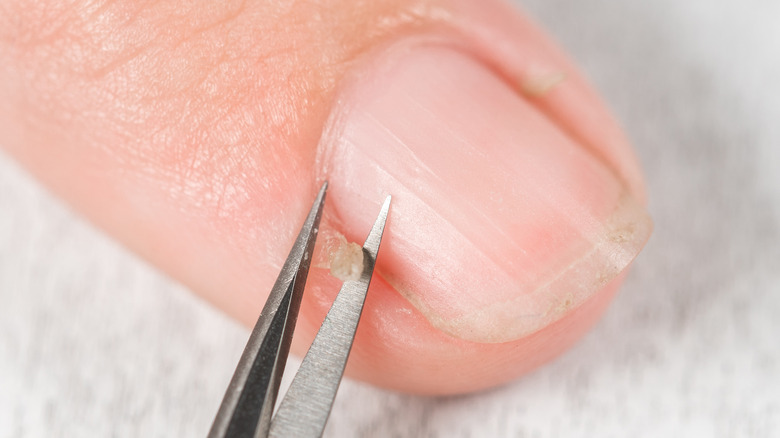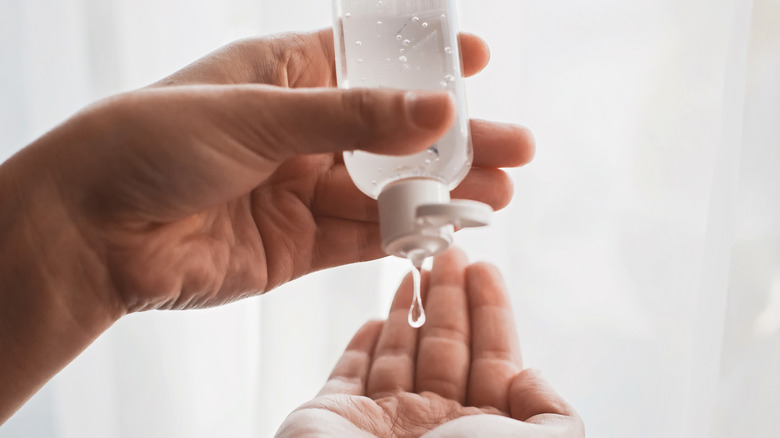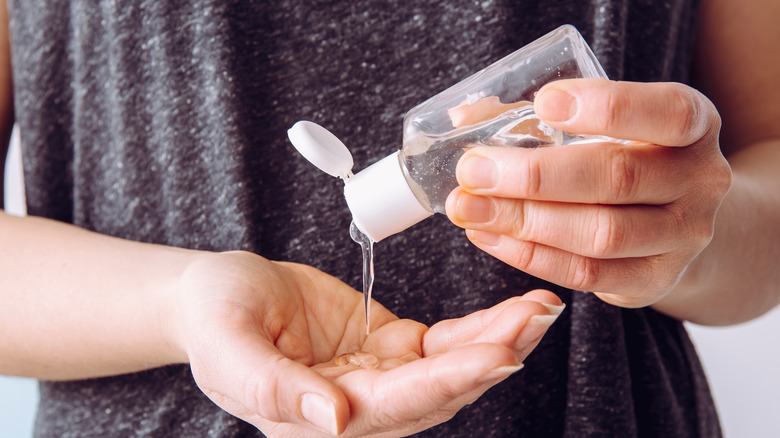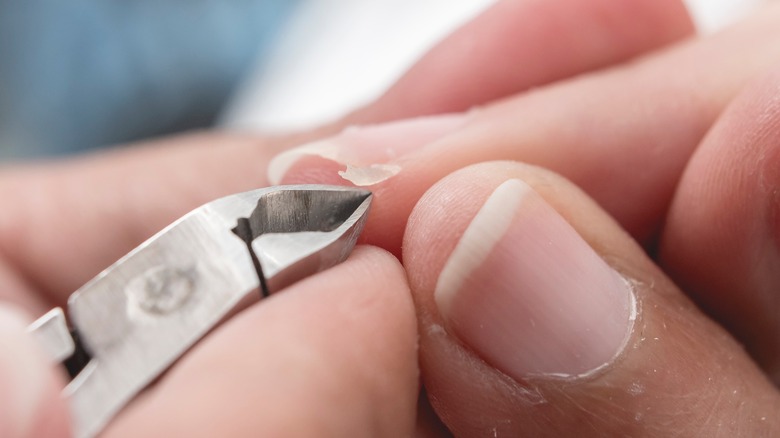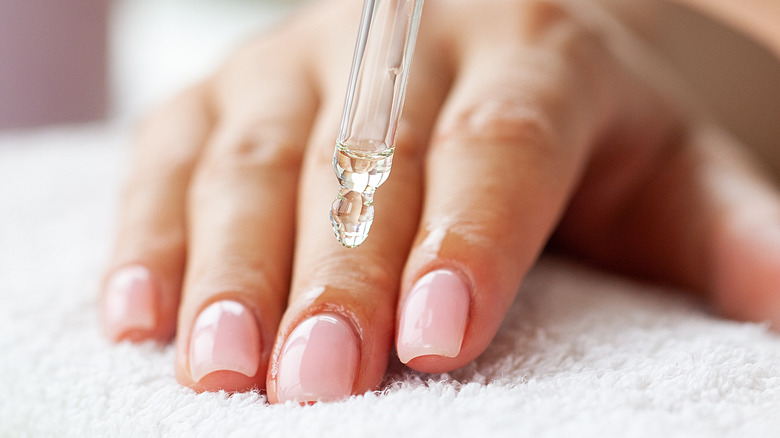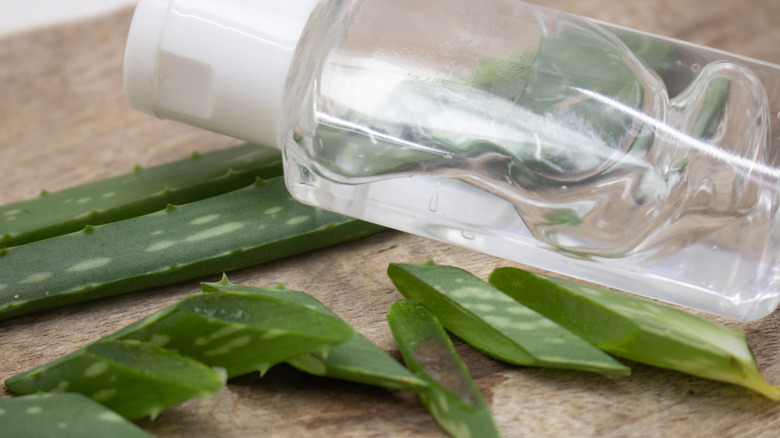The Trusty Hand Product That Could Be Causing Hangnails (& What To Do About It)
Painful, agitating, and a downright hassle to deal with — say hello to the hangnail. They come in all shapes and sizes and offer a wide variety of annoying characteristics. Not only do these flimsy slivers of broken skin hurt, they are notoriously irritating to fix — and that's if you even know how. If you often find yourself dealing with that dreaded piece of torn skin flapping around your fingers, you may wonder what's causing it and how to eliminate it once and for all.
While it may not be a surprise, some of the most common causes of hangnails include nail biting, nail picking, damaged nails, swimming pools, and even winter weather. These factors can each play a significant role, separately or together, in causing the ever-so-dreaded hangnail to form. However, there could also be another guilty culprit when it comes to hangnails — and it may even be lurking in the shadows of your home.
Hand sanitizer could give you hangnails
While it may seem like a quick and easy option for cleaning your hands, hand sanitizer can negatively impact your skin. Even worse, it can cause hangnails. Yes, that's right — the ever-so-convenient little bottle in your handbag might be ruining your whole day by creating an annoying flap of flesh. It does this by drying out your epidermis, which can lead to cracking skin, or, more specifically, skin cells splitting off to form a hangnail. This is especially true if the hand sanitizer is being applied around your nail area. Doing this turns that sensitive skin into an arid desert, which is the hangnail's preferred environment.
If you often use hand sanitizer, it may be best to tone it down and stop using it so frequently. However, if you find it challenging to stop cleaning your hands, swapping it out for soaps with more moisturizing qualities might help. Save the sanitizer for outdoor trips and head back to the sink.
Harsh chemicals dry out your hands and cause hangnails
Hand sanitizer causes hangnails because of its drying qualities. Where do these drying qualities come from? Harsh chemicals in this popular hand product are often to blame, such as isopropyl and n-propanol alcohols, per Olansky Dermatology. These ingredients are often prime suspects when it comes to dry skin, as they remove sebum, making it harder for skin to stay hydrated. Drying your skin only increases your risk of provoking an unwanted hangnail. As board-certified dermatologist Dana Stern explained to Yahoo! Life, "People who work with a lot of chemicals often will be more prone to getting hangnails."
In addition to hand sanitizers, soaps containing sulfates and ethyl can also be particularly drying on the skin, which can lead to more pesky hangnails flaring up. You might switch to hand soaps to prevent hangnails, but if you're still lathering your skin with these chemicals, you'll keep on facing the same problem. If you want to counter this, try looking for soaps without these ingredients, especially those that contain more moisturizing elements.
How to safely remove a hangnail
Following these guidelines is all well and good, but sometimes, you're still going to get a hangnail. Nobody wants a pesky piece of skin flapping around, ruining a pair of beautifully manicured hands. Luckily, if you fall victim to hangnails, you can easily and safely remove them with minimal fuss or hassle. So, how do you do it?
Start by soaking your hands with soap and warm water to help clean and loosen your hangnail. Now it should be ready for removal. Speaking to Cleveland Clinic, Dr. Neha Vyas recommends using sterilized nail clippers to snip the irritating hangnail off. Remove as much of the hangnail as possible before applying an antibacterial ointment or petroleum jelly to the area. This will help keep the area clean and prevent infection. If the area bleeds when you cut it, rinse and apply pressure until it stops. You can then add some antibacterial ointment to keep it clean.
Following these steps should help you safely remove any pesky hangnails. However, there are also plenty of ways that you can prevent hangnails, even if you often find yourself using hand sanitizer.
Use cuticle oil to prevent hangnails
Getting to the root of the issue is the best way to prevent the skin on your nails from getting a mind of its own. If you keep your hands hydrated and in good condition, then your chances of developing hangnails should drop. One great way to do this is to apply cuticle oil to your nails, which will help to keep them hydrated and moisturized. However, this isn't the only way that you can prevent hangnails.
You should also moisturize your hands regularly (with added focus on the cuticle area), which will help keep the area hydrated and combat dryness due to using hand sanitizer or washing your hands frequently. This is particularly true during winter, when drier air tends to dehydrate your skin more. You can combat winter dryness by wearing gloves, which will help to protect your hands and the area around your nails. Likewise, you should take care not to pick or bite your nails, or use products with acetone on your nail area. This is because acetone dries the skin, encouraging hangnails to form.
Swap your hand sanitizer for one with hydrating ingredients
If you use hand sanitizer regularly and aren't looking to change your habits, then it may be worth investing in a sanitizer that's more hydrating for your skin. Some hydrating ingredients to keep an eye out for include glycerin, aloe vera, eucalyptus, shea butter, vitamin E, and coconut and jojoba oils. These ingredients will help keep your nails and cuticles more hydrated, even if you're frequently applying hand sanitizer. However, because all hand sanitizers contain alcohol, even the best product will still dry your skin out to a certain extent. This could encourage hangnail growth. It is for this reason that it's important to keep your hands hydrated and moisturized if you use this hand product, no matter how excellent its recipe.
Your best bet for preventing hangnails while using hand sanitizer is to keep your hands and nails as moisturized as possible, particularly during the winter months. If you're consistent, then you should begin to see a decrease in the number of hangnails you get.
